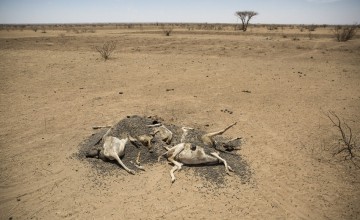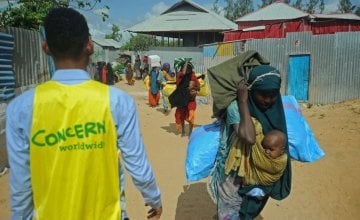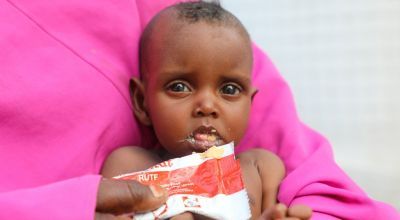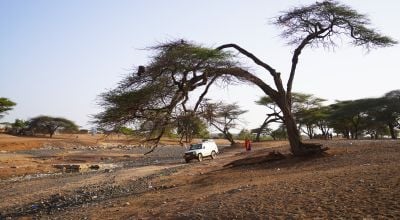
Read our 2023 annual report

Knowledge Hub
How a rapid response helped to avert famine in Somalia this year

Concern's Humanitarian and Resilience Senior Policy Officer, Alexander Carnwath, and Resilience Programme Manager in Somalia, Dustin Caniglia examine the effectiveness of early warning systems and rapid response in helping to avert famine in Somalia this year and their continued importance in 2018.
Fears for the worst
When Somalia was cited as one of four countries on the brink of famine in early 2017, it brought on a grim sense of déjà vu. Between 2010 and 2012, a combination of drought and conflict led to a devastating famine, in which an estimated 260,000 people lost their lives. Five years on there were fears that a similar situation was unfolding all over again.
A year later however, and the picture is not as bleak as had been feared. The humanitarian response, with aid targeted at some of the worst affected areas, has so far succeeded in staving off widespread famine. The situation remains severe and, following four consecutive poor rainy seasons, there is a huge and ongoing demand for humanitarian assistance with an estimated 6.2 million people in need. But the predictions that were made at the start of the year of a disaster on the scale of the last famine have not yet materialised.
Early Warning System: Identifying the signs
This is thanks in part to a more rapid reaction by the humanitarian community than in 2012, and Concern has been one of the agencies focusing particularly on ensuring a timely response. Early Warning Early Action (EWEA) - identifying and responding more quickly to the signs of coming crisis - is a central part of the DFID-funded Building Resilient Communities in Somalia (BRCiS) programme which Concern is implementing together with Norwegian Refugee Council, International Rescue Committee (IRC), Save the Children and CESVI. It systematically monitors conditions in its programme areas and includes a mechanism to trigger a rapid localised response when signs of a potential crisis emerge.
Rapid response
Most of Somalia depends on two annual rainy seasons for agriculture and livestock production, and when, as early as June 2016, there were signs that the April to June Gu rains were not performing well, BRCiS began responding with cash transfers of $30 per month to 803 of the poorest households in Gedo.
In November, as the subsequent Deyr rains appeared to be failing and the probability of disaster had therefore increased, Concern increased the amount to $50 per month and doubled the number of recipient households to 1606, now including the poorest 20 percent of households.
By January 2017, with the failure of the rains confirmed, Concern was able to increase the cash transfers to $60 per month with newly accessed emergency funds from DFID and ECHO. Despite the crisis, markets continued to function and food remained available for purchase, minimising displacement to urban centres.

Increased resilience
Our approach to EWEA meant that by the time the Food Security and Nutrition Analysis Unit (FSNAU) - the leading source of food security and nutrition surveillance in Somalia - indicated the possibility of famine in Somalia for the first time in a report published on 16 January, 2017 Concern’s BRCiS Programme staff had already been responding to that possibility in half of its target communities for seven months.
Ongoing discussions with the BRCiS target communities and observations by Concern field staff, suggest that as a result of this early action, the villages in which BRCiS operates are faring considerably better than might have been expected. While over 900,000 households have been displaced across the country since November 2016, none of the BRCiS villages have experienced significant numbers of people leaving due to the drought. In fact, even though BRCiS communities were originally targeted as the most vulnerable in their respective areas, most have since become hosts to displaced people from nearby and previously “better off” villages.
Averting future crises: early and effective response
It is important, of course, to keep these successes in perspective. BRCiS programme was a pilot through which Concern supported fewer than 30 villages, a number that pales in comparison to the 900,000 people forced to leave their homes and seek refuge in urban centres due to the food crisis. But this does show what can be achieved in mitigating the impacts of major slow-onset disasters in Somalia.
With millions of people still affected by food crisis in Somalia, it remains imperative to learn the lessons of the past two years and continue to respond to emerging needs early and effectively, in order to continue to keep famine at bay.
About the authors
Alexander Carnwath is a Senior Policy Officer on Resilience and Humanitarian Response at Concern Worldwide. He coordinates the organisation’s global advocacy work on Somalia and Lake Chad Basin.
Dustin Caniglia manages Concern’s Building Resilient Communities in Somalia Programme, where he applies management innovations toward decentralized programme structures and the cost-effectiveness of mitigating humanitarian disasters.
Learn more about Concern
Learn more about the diversity of our work in 26 countries worldwide
Thought leadership series
- A solution to extreme poverty? Graduation programmes pave the way
- Urban diasasters: Preventing another tragedy in Freetown
- Four major food crises in 2017: What's going wrong?
- Conflict often breeds disaster. So why is it neglected in Disaster Risk Reduction?
- Innovations for maternal and newborn health: Getting from 'great ideas' to 'global lifesavers'





